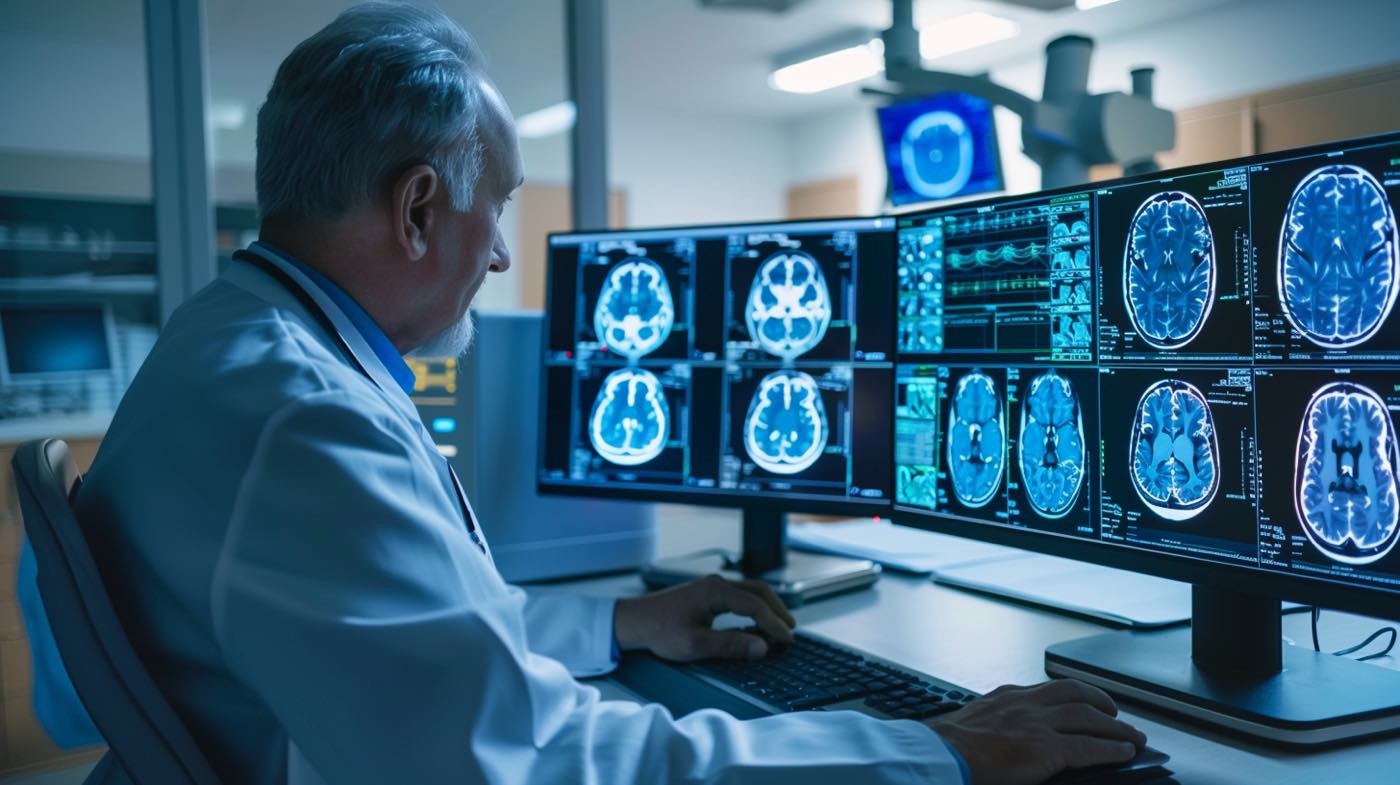AI in Healthcare: Here is What You Need to Know
We are witnessing a revolution with AI in healthcare! With unprecedented diagnostics, treatment options, and data management improvements, the cure for debilitating diseases may be closer than you think.
In 2019, the National Institutes of Health published an article in the National Library of Medicine that made bold AI predictions. Five years later, most of their ‘predictions’ are natural parts of the industry.
However, integrating AI into healthcare doesn’t come without risk. Before understanding the risks, it’s essential to understand how AI works and where it’s applied. Today’s implementation can generally be divided into three categories–diagnostics, treatment personalization, and patient data management.
How AI in Healthcare Works
We know healthcare uses AI, but how?
First, this is a highly complex process. This overview is a severe oversimplification meant only to scratch the surface. For a deeper dive into some more resources, check out the World Health Organization’s strategic plan.
It all starts with training an AI model to detect patterns and accurately identify anomalies in data inputted by medical professionals.
Consider this ‘best-case scenario’. You go to the doctor with a severe headache. She decides to do an MRI. With AI, she can isolate the issue nearly instantaneously because the model has compared the images to thousands of others.
It has filtered out irrelevant conditions, and the doctor can view a narrowed list of potential diagnoses. Because of AI, your ‘test results’ take minutes instead of days or weeks. At no time did your provider hand the keys over to AI to make the care decision; the model simply processed vast amounts of data to streamline patient care effectively.
Let’s talk about how the process works.
Training, Validation, Testing Datasets
Medical professionals analyze, sanitize, label, and classify millions of records from patient medical histories, diagnostic imaging, genetic sequences, medication regimens, clinical trials, and more. Researchers split the data into three sets: training, validation, and testing.
Training
Most of the data is sent to a training set that will teach what the AI model is looking for. This process is heavily influenced by medical researchers and practitioners who are inputting data and verifying data from others. This data is creating an accurate—human-verified—reflection of what ‘right’ looks like.
Think about teaching a toddler shapes and colors. You have a flashcard with a picture of a green square, and you tell the child, “This is a green square.” You repeat this several times every day for a month. Ideally, the repetition builds knowledge of shapes and colors in the child’s mind.
Validation
Another data set serves as the validation set—essentially, it modifies and adjusts the model to analyze additional data accurately. Based on the parameters set up in the training data, the model is now attempting to analyze the new data. When it interprets the data incorrectly, adjustments are made, and the process is restarted.
Now, you only show pictures to the toddler. You ask the toddler to identify the shape and then the color. You can step in if they get stuck to reinforce the learning, but you are not actively involved from the start anymore.
Test
Finally, the remaining data is used as test data. The model has been trained, and its analysis has been validated by humans. Now, the AI forms its own conclusion from the data inputs. Still, humans are involved in verifying that the model consistently and accurately interprets the data.
Now, you show the toddler cards with the same shapes and colors, but they are all mixed up. Instead of a ‘green square’ and a ‘yellow triangle’, the square is now red and the triangle is pink. The toddler is tested on their ability to identify the shape and the color independently. This ensures they understand the ‘data’ and are not just working from memory.
Review
Importantly, highly trained and qualified humans are heavily involved throughout the entire process. The model depends on validated inputs to learn to interpret new data. AI is capable of errors. It can (and will) draw incorrect conclusions. However, the processing speed and accuracy of feedback is far more effective than humans.
Once the AI model is trained and ‘ready’ for real-world use, it undergoes extensive regulatory and ethical review before being deployed into a real-world environment. The process is complex, and extensive safeguards protect the privacy and use of the data.
How AI in Healthcare is Used
The potential applications of AI in healthcare are still unknown. There is a lot of promise in many areas yet to be explored. For this overview, let’s look at three areas where AI is already used—diagnostics, treatment personalization, and patient data management.
Diagnostics
Traditional Diagnostics
For thousands of years, humanity’s capacity to diagnose and treat disease has been limited to the tangible research of medical professionals. It’s staggering to think about the number of patients who died from easily treatable and preventable ailments.
Consider George Washington. Had he not been drained of 50% of his blood, the likely outcome of his throat infection—even without treatment—would have been vastly different. But, three doctors and an untrained assistant drained his system of more than a half-gallon of blood in just 12 hours.
When medical discovery was limited to the observation knowledge of a single individual—and even the gradual growth of collective research resources, diagnoses were incomplete and often entirely wrong.
AI Diagnostics
Today, AI enhances diagnostics through millions of data points with staggering accuracy. AI models can analyze X-rays, CT scans, MRIs, and countless other medical data sources to compile a highly accurate dataset from millions of global patients.
Algorithms can detect patterns and abnormalities that human observation could never perceive. Early detection of conditions like cardiovascular disease and cancer is already revolutionizing diagnoses and medical interventions.
The benefit of AI implementation in diagnostics means there is hope for millions battling—or who may someday battle—disease. With more speed and accuracy in diagnosing disease, AI transforms healthcare and enhances patient outcomes. I’m looking forward to a healthier future.
Treatment Personalization
Traditional Treatment
Historically, medical treatments were based on generalized methods that didn’t account for the diversity of patients. This one-size-fits-all approach frequently led to treatment options that worked remarkably well for some patients but either 1) didn’t work or 2) caused adverse outcomes for others.
Consider the early days of chemotherapy. Doctors used a ‘standard’ treatment regimen for all cancer patients, regardless of patient genetics, type of cancer, stage of cancer, or medical history. This led to ineffective high doses that indiscriminately destroyed healthy tissue. Research also failed to recognize that some cancers developed resistance to chemotherapy drugs, which only prolonged toxic treatment regimens.
AI in Treatment Personalization
Today, AI continues to revolutionize treatment personalization by parsing vast patient data. Unique genetics, lifestyles, and medical history are crucial components of treatment plans that are now efficiently analyzed. AI models can predict how patients respond to various treatments, allowing healthcare providers to tailor treatment plans to individual needs.
Machine learning algorithms identify optimal drug combinations and dosages, minimizing side effects and enhancing efficacy. This personalized approach improves treatment outcomes and patient satisfaction.
Through the implementation of AI in treatment planning, healthcare providers can provide targeted care that transforms outcomes and sets new standards in medicine.
Patient Data Management
Traditional Patient Data Management
Managing medical records used to be an inefficient, labor-intensive process prone to human error at every step. Retrieving medical histories required time-consuming searches through stacks of paper records, which could easily be misplaced.
This administrative burden hindered healthcare providers’ ability to deliver effective patient care. Reliance on physical records hampered communication and coordination among healthcare providers, leading to fragmented care and increased risk of errors.
Switching doctors and getting 2nd opinions were impractical or cost-prohibitive.
AI Patient Data Management
AI now serves as the epicenter of patient data management. It automates the organization, analysis, and retrieval of medical records with unprecedented accuracy and efficiency. AI-driven systems can handle volumes of data to streamline patient data.
Use and Benefits:
- Data Management and Accessibility: AI systems store patient data in an electronic health record (EHR) that can be easily accessed by all healthcare service providers. Not only does this speed up workflows, but it also provides clinicians with a complete and accurate picture of patient history.
- Error Reduction: Automating data entry and management reduces human errors associated with manual record keeping, ensuring reliable and highly precise patient records.
- Predictive Analytics: AI models can detect patterns and predict health trends well before human researchers can. For example, predictive models may anticipate disease outbreaks or identify patients at high risk for certain conditions to promote early intervention or preventive care. This is only possible through deep data analysis.
Summary
Technological advancement has placed the patient at the center of healthcare. Medical professionals can streamline administrative and technical research tasks to focus on patient care. These advances make healthcare efficient, enhance patient outcomes, and set high standards for patient care.
The integration of AI can also drive the cost of medical procedures down, significantly increasing the accessibility of (now) expensive care.
Medical professionals retain their position of authority in care, but their roles can focus more on the specialized experience they possess and less on the administrative minutia that monopolizes their time.
What Does This Mean?
The future of AI in healthcare is not void of risk. There will be ethical dilemmas and treatment missteps. But, with fear of being crass, welcome to medicine. Ethical dilemmas and treatment missteps have defined the medical field since the beginning. It’s tragic, but true.
Integrating AI creates a scapegoat when something goes wrong. It will be easy to blame a medical model for errors in diagnosis, treatment, and data breaches.
But before we jump to conclusions on the dark side of AI, let’s consider the vast benefits it introduces. Think of a loved one enduring a debilitating illness right now. Know that there are AI models in training at this moment, trying to build diagnoses and treatment options for that condition.
I am a firm believer that the prevention and cure for conditions like cancer, MS, dementia, Alzheimer’s, and so many more human ailments are at our fingertips.


